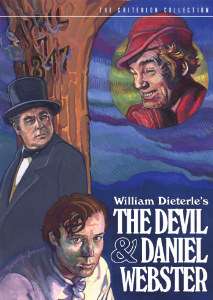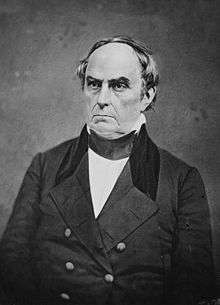The Devil and Daniel Webster (film)
The Devil and Daniel Webster is a 1941 fantasy film, adapted by Stephen Vincent Benét and Dan Totheroh from Benét's 1936 short story, "The Devil and Daniel Webster". The film's title was changed to All That Money Can Buy to avoid confusion with another film released by RKO that year, The Devil and Miss Jones, but later had the title restored on some prints. It has also been released under the titles Mr. Scratch, Daniel and the Devil and Here Is a Man. The film stars Edward Arnold, Walter Huston, and James Craig.
| The Devil and Daniel Webster | |
|---|---|
 DVD cover | |
| Directed by | William Dieterle |
| Produced by | William Dieterle Charles L. Glett |
| Written by | Dan Totheroh Stephen Vincent Benét |
| Based on | The Devil and Daniel Webster by Stephen Vincent Benét |
| Starring | Edward Arnold Walter Huston James Craig Anne Shirley Jane Darwell Simone Simon |
| Music by | Bernard Herrmann |
| Cinematography | Joseph H. August |
| Edited by | Robert Wise |
Production company | William Dieterle Productions |
| Distributed by | RKO Radio Pictures |
Release date |
|
Running time | 107 mins |
| Country | United States |
| Language | English |
A retelling of the Faust legend, set in 1840s rural New Hampshire, it was directed by German-born actor-director William Dieterle who (under his original name, Wilhelm Dieterle) played a featured role in F. W. Murnau's epic silent version of Faust in 1926.
Plot
In 1840 New Hampshire, Jabez Stone, a poor kindhearted farmer, is broke and plagued by bad luck. After a series of mishaps, he impulsively declares that he would sell his soul to the devil for two cents, and moments later the devil appears, calling himself "Mr. Scratch". He appears to offer Jabez a bargain: sell his soul in return for seven years of good luck and prosperity. Scratch tempts Jabez by magically revealing a hoard of Hessian gold coins, which appears from under the barn floor, and, unable to resist the lure of the gold, Jabez signs the contract. He begins his new life with hope, paying off his debts and buying new tools and supplies. While the women are shopping, Jabez meets and becomes friends with the celebrated Massachusetts Congressman and orator Daniel Webster, a friend of his wife's family, and a widely loved figure who champions the cause of the poor farmers. Webster himself is being tempted by Mr. Scratch to sell his soul, in return for fulfilling his ambition to become President of the United States.
As time passes, Jabez's increasing wealth begins to change him. He ensnares his desperate neighbors with onerous financial contracts, and he slowly alienates his devoted wife Mary and his pious mother. Later, as the townspeople celebrate the harvest in Jabez's barn, Mary gives birth to their first child, whom they name Daniel in honor of Mr. Webster, but minutes later, Jabez discovers that the local girl they had hired as a maid has vanished. In her place, he finds the beautiful and sinister Belle who has been sent by Mr. Scratch. She bewitches Jabez, driving a wedge between him and Mary. As Daniel grows, he too falls under Belle's malign influence, and she turns him into a spoiled, disobedient brat.
In a few more years, Jabez is one of the richest men in the country: he has built a lavish mansion and throws a huge ball, but it ends in disaster: after a nightmarish dance between Belle and Miser Stephens, Jabez finds Stephens dead on the floor. He, too, had signed a pact with Mr. Scratch and his time was up. Now desperate and realizing that his own time is almost up, Jabez tries to erase the deadline Mr. Scratch has burned into the tree outside the barn, but Scratch appears and again tempts Jabez, offering to extend his deal in return for the soul of his son. Horrified, Jabez flees and chases after Mary. He begs her forgiveness and pleads with Webster to help him find some way out of his bargain with the devil. Webster agrees to take his case. Mr. Scratch again offers an extension in exchange for Jabez's son, but Jabez turns him down. He then begs Webster to leave before it is too late, but Webster refuses to go.

When Mr. Scratch shows up to claim his due, Webster has to wager his own soul before his fiendish opponent will agree to a trial by jury. Mr. Scratch chooses the jury members from among the most notorious personalities of American history (including Benedict Arnold) with John Hathorne (one of the magistrates of the Salem witch trials) as the judge. Webster begins by stating that he envies the jury because, as Americans, they were present at the birth of a nation, but they were fooled like Jabez Stone, trapped in their desire to rebel against their fate. Webster explains that it is the eternal right of everyone, including the jury, to raise their fists against their fates. They took the wrong turn, just as Stone did, but Stone's soul can be saved.
After a few moments, Hathorne asks the jury for their verdict and, in response, the foreman, Arnold, tears up the contract, releasing Jabez from his deal. Webster then kicks Mr Scratch out, but, as he is ejected, the fiend promises that Webster will never fulfill his ambition to become President. Scratch sits alone, resignedly thumbing through a notebook. He puts it away and then breaks the fourth wall, moving his gaze until he stops, looks straight ahead and points wordlessly at the viewer.
Cast
- Edward Arnold as Daniel Webster
- Walter Huston as Mr. Scratch
- James Craig as Jabez Stone
- Anne Shirley as Mary Stone
- Jane Darwell as Ma Stone
- Simone Simon as Belle
- Gene Lockhart as Squire Slossum
- John Qualen as Miser Stevens
- H. B. Warner as Justice John Hathorne
- Alec Craig as Eli Higgins
- George Cleveland as Cy Bibber
- Lindy Wade as Daniel Stone
- Jeff Corey as Tom Sharp (uncredited)
- Carl Stockdale as Van Brooks (uncredited)
Production
After the success of The Hunchback of Notre Dame (1939), William Dieterle founded his own production company and signed a contract with RKO Radio Pictures, the studio that had produced the film. He decided to adapt Stephen Vincent Benet's short story of the same name as the first film he would make under the contract with the studio.
The story had been adapted to the stage in 1939 at the Martin Beck Theater to great acclaim, but only ran for six performances because the production proved to be expensive. It was also later adapted as an opera that was performed during World War II by USO troupes.
Benet was invited to write the script for the film adaptation, along with Dan Totheroh, the younger brother of Roland Totheroh, who worked as Charlie Chaplin's top cinematographer from his silent short films to Monsieur Verdoux (1947). There were some differences between the short story and the film. In the original story, Webster regrets Benedict Arnold's absence; in the film, Arnold is present and Webster objects, citing him as a traitor and therefore not a true American, but his objection is dismissed by the judge, and Asa the Black Monk is made up for the film, along with John Smeet, who appears in a deleted scene. The writers also cut out Scratch's other predictions involving Webster's last speech and his sons' deaths in the Civil War. Mr Scratch, Walter Huston's character, was more soft-spoken in the story and the character of Belle was an addition.[1]
Thomas Mitchell was the original choice for Daniel Webster, but he suffered a skull fracture while filming the carriage scene and was replaced by Edward Arnold.
Bernard Herrmann was chosen to compose the film, having composed music for Charles R. Jackson's 1938 radio adaptation that had aired on The Columbia Workshop. Herrmann was introduced to the cast and crew by Dieterle, whom he found to be a very sophisticated director. In addition to his original music score, Herrmann also incorporated several traditional folk tunes, including "Devil's Dream", "Springfield Mountain", and a diabolical version of "Pop Goes The Weasel" played on the fiddle by Mr. Scratch. Herrmann collaborated with sound engineer James G. Stewart to ensure the music and sound worked well together. To create the creepy sound when Mr. Scratch first appeared in the barn, Herrmann had a recording crew go to San Fernando to record the sound of telephone wires.[2]
Alternative versions
The original release was 107 minutes long. It was a critical, but not a box-office, success, recording a loss of $53,000 on its initial run.[3] It was later re-released under the title The Devil and Daniel Webster, reducing the film to 85 minutes. The cuts were crudely done. The film was restored to its full-length in the 1990s and has been issued in that form on home video. However, the title has remained The Devil and Daniel Webster. The restored portions on the video had been taken from inferior prints of the movie, but the quality has since improved. A preview print titled Here Is a Man was found in the estate of the director and served as the basis for the film's restoration and DVD release.
Parodies
The Simpsons featured a comedic spoof of "The Devil and Daniel Webster" in "Treehouse of Horror IV" (1993). It was called "The Devil and Homer Simpson" and it included a court case including “American betrayers” which included the 1976 Philadelphia Flyers. The devil was played by Ned Flanders.
Awards and honors
Bernard Herrmann won the Academy Award for Best Music, Scoring of a Dramatic Picture and Walter Huston was nominated for Academy Award for Best Actor.
See also
- Politics in fiction
- Shortcut to Happiness, a 2003 modernised remake
References
- Izzo, David Garrett; Lincoln Konkle (2002). Stephen Vincent Benet:Essays on His Life and Work. University of California Press. ISBN 0786413646.
- Smith, Steven C. A Heart At Heart's Center: The Life and Music of Bernard Herrmann. University of California Press. p. 86. ISBN 0-520-07123-9.
- Richard Jewell & Vernon Harbin, The RKO Story. New Rochelle, New York: Arlington House, 1982. p. 166
External links
| Wikiquote has quotations related to: The Devil and Daniel Webster (film) |
- The Devil and Daniel Webster on IMDb
- The Devil and Daniel Webster at AllMovie
- The Devil and Daniel Webster at the TCM Movie Database
- The Devil and Daniel Webster at Rotten Tomatoes
- The Devil and Daniel Webster an essay by Bruce Eder at the Criterion Collection